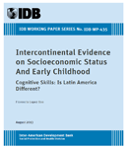Intercontinental Evidence on Socioeconomic Status and Early Childhood: Cognitive Skills: Is Latin America Different?
Date
Aug 2013
This paper documents disparities in cognitive development- as measured by a receptive vocabulary test-between children from households with high and low socioeconomic status (SES) in two different phases of childhood (before and after early school years) in four developing countries: Peru, Ethiopia, India, and Vietnam. Intercontinental evidence on the timing, shape, pattern, and persistence of these disparities is provided. The nonparametric analysis suggests that disparities found at age 5 persist into the early school years across all four countries, and the conditional analysis shows that SES disparities seem to fall over time. However, both the magnitude of the gap and the degree of persistence vary. The main result is that Peru stands out, not only as the country with the largest cross-section disparity between rich and poor (of around 1.30-1.40 standard deviations), but also as the country with the highest persistence in cognitive development, as shown by the value-added specification. The latter suggests fewer opportunities for convergence in cognitive development between rich and poor over time in this Latin American country. Some channels behind these trends are discussed, but overall, the SES gradient persists even when controlling for a large number of important mediators, such as preschool, early nutrition, and schooling. Past performance on the Peabody Picture Vocabulary Test (PPVT) is the most important mediator of the SES gradient at age 8.




